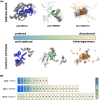Protein interactions: anything new?
- PMID: 36416856
- PMCID: PMC9760424
- DOI: 10.1042/EBC20220044
Protein interactions: anything new?
Abstract
How do proteins interact in the cellular environment? Which interactions stabilize liquid-liquid phase separated condensates? Are the concepts, which have been developed for specific protein complexes also applicable to higher-order assemblies? Recent discoveries prompt for a universal framework for protein interactions, which can be applied across the scales of protein communities. Here, we discuss how our views on protein interactions have evolved from rigid structures to conformational ensembles of proteins and discuss the open problems, in particular related to biomolecular condensates. Protein interactions have evolved to follow changes in the cellular environment, which manifests in multiple modes of interactions between the same partners. Such cellular context-dependence requires multiplicity of binding modes (MBM) by sampling multiple minima of the interaction energy landscape. We demonstrate that the energy landscape framework of protein folding can be applied to explain this phenomenon, opening a perspective toward a physics-based, universal model for cellular protein behaviors.
Keywords: energy landscape framework; fuzziness; higher-order assembly; liquid-liquid phase separation; protein-protein interactions.
© 2022 The Author(s).
Conflict of interest statement
The authors declare that there are no competing interests associated with the manuscript.
Figures




References
Publication types
MeSH terms
Substances
LinkOut - more resources
Full Text Sources

